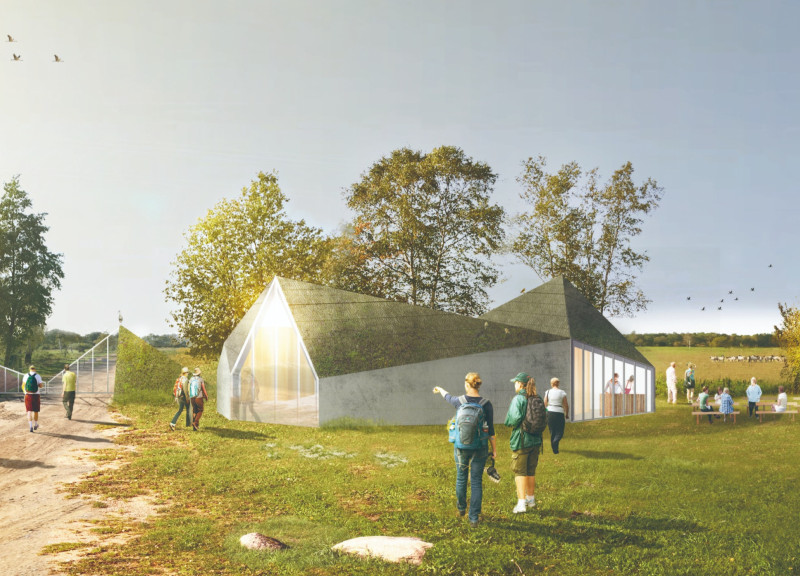5 key facts about this project
At its core, the Pape Nature Gateway represents a commitment to sustainability and community engagement. The design utilizes a combination of distinct geometric forms, notably a polyhedral structure composed of triangular surfaces that not only provide aesthetic intrigue but also address practical concerns such as rainwater harvesting. This innovative architectural approach showcases a blend of form and functionality, allowing the building to contribute positively to its environment. The choice of materials further reinforces the project’s ecological intentions, with timber, reinforced concrete, glass, and vegetation playing crucial roles. Timber provides a warm and inviting aesthetic, while the use of reinforced concrete offers necessary structural support. Glass elements enhance natural light and ensure ongoing visual connectivity with the park’s scenic vistas.
The layout of the Pape Nature Gateway organizes key functional areas to facilitate efficient visitor movement and interaction. Areas such as the ticket counter, information stands, campsites, and outdoor kitchens are strategically placed to encourage exploration and usability. Visitors are directed through these spaces in a fluid manner, promoting a seamless experience. Each of these functional components, including toolboxes that serve as showers and storage, is cleverly integrated into the site, making them accessible while still maintaining a degree of privacy and comfort.
One of the standout features of this architectural design is the main gateway, which serves as the entrance to the park. The gateway’s geometric concentration and integration of green roofs create a welcoming visual cue that entices visitors to discover what lies beyond. The design actively encourages interaction and connection, not only with the building itself but also with the beautiful natural landscape it sits within. Signage placed around the gateway aids in orienting visitors as they arrive, offering essential information about the park and enriching their experience.
Sustainability is a central theme throughout the Pape Nature Gateway's design. The incorporation of energy solutions such as solar panels illustrates a proactive stance toward environmental responsibility. Moreover, the rainwater harvesting system underscores a commitment to resource conservation, demonstrating how the architecture operates harmoniously within its ecological context. The building's envelope features large glass panes that invite daylight in while ensuring a visual dialogue with the outdoors. The result is interior spaces that feel expansive and connected, echoing the natural environment.
Landscaping around the site has been carefully planned to complement the architecture and encourage outdoor activities. With designated picnic areas, playgrounds, and spacious camping spots, the project fosters communal engagement among families and visitors while enhancing the overall recreational experience. These features are designed so that they blend with the natural surroundings, creating a cohesive aesthetic that does not detract from the beauty of the natural park.
The uniqueness of the Pape Nature Gateway lies in its holistic approach to design. The architecture does not merely serve functional needs; it also expresses a sensitivity to the natural setting and the activities it supports. This makes the project a commendable example of how architecture can function as a bridge between human experience and nature. By being mindful of environmental impact while providing spaces that encourage social interaction, the design promotes a culture of sustainability and community.
Overall, the Pape Nature Gateway exemplifies an architecture that is not only functional but also reflective of the needs and desires of its users, as well as its environmental context. For those interested in further exploring this project, including architectural plans, sections, and design ideas, it is encouraged to engage with the presentations available, which provide deeper insights into this unique architectural endeavor.


























